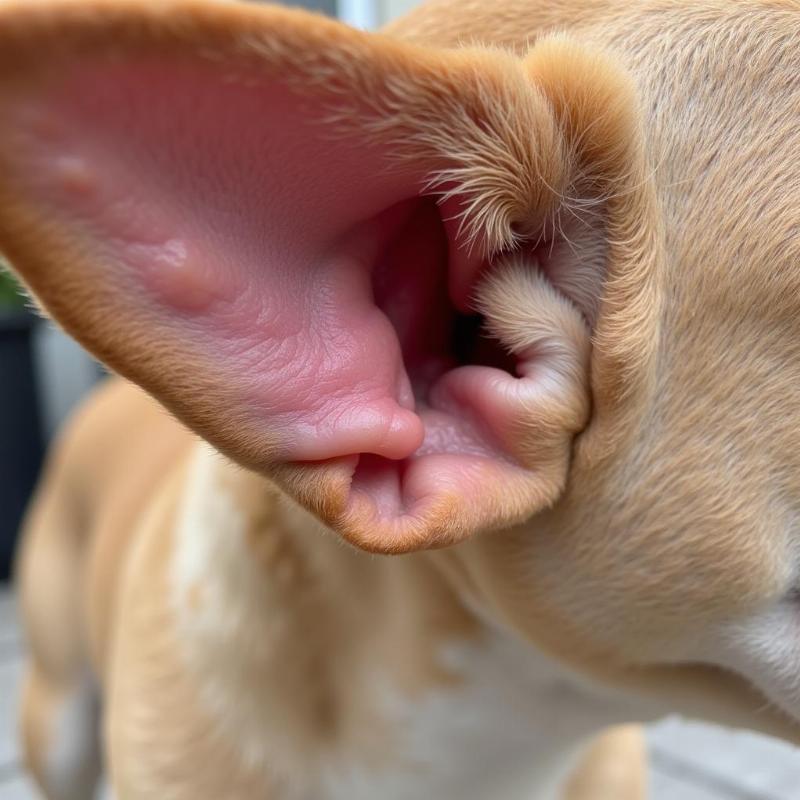Yeast infections in dogs’ ears are a common problem, often causing discomfort and distress. Recognizing the early signs, especially through visual cues, is vital for prompt treatment and preventing further complications. This article will help you identify the early stage visual indicators of a yeast infection in your dog’s ears. We’ll explore the subtle changes to look for, explain why these changes occur, and guide you on the next steps to take if you suspect your furry friend has a yeast infection.
 Hình ảnh nhiễm trùng nấm men giai đoạn đầu ở tai chó
Hình ảnh nhiễm trùng nấm men giai đoạn đầu ở tai chó
Many dog owners initially struggle to differentiate between normal earwax and the early stages of a yeast infection. Healthy earwax is typically light brown and has a relatively dry, flaky consistency. However, with a budding yeast infection, you might notice a change in color and texture. The wax can become darker, ranging from tan to dark brown, and take on a more moist, pasty, or even slightly greasy appearance. This change is often accompanied by a slightly unpleasant, musty odor.
What causes this transformation? Yeast, a type of fungus, thrives in warm, moist environments. Your dog’s ear canal provides the perfect breeding ground, especially if it’s poorly ventilated or prone to moisture buildup. As the yeast multiplies, it produces waste products that contribute to the discoloration and change in texture of the earwax.
Another telltale sign of an early-stage yeast infection is mild redness within the ear. While significant inflammation is a marker of a more advanced infection, the initial stages often present with subtle redness along the inner folds and the base of the ear. This redness is caused by the inflammatory response triggered by the yeast overgrowth. Your dog might also start scratching their ear more frequently or shaking their head in an attempt to alleviate the discomfort.
Recognizing Early Stage Visual Cues
- Changes in Earwax: Look for a shift from light brown, dry earwax to a darker, moister, and possibly more odorous discharge.
- Mild Redness: Notice subtle redness inside the ear, particularly along the folds and base.
- Increased Scratching: Observe if your dog is scratching their ear or shaking their head more often than usual.
What to Do If You Suspect a Yeast Infection
If you notice any of these early signs, it’s crucial to consult your veterinarian. They can accurately diagnose the issue and recommend appropriate treatment, usually antifungal ear drops or medications. Early intervention can prevent the infection from progressing and causing more severe symptoms like intense itching, swelling, pain, and even hearing loss.
Conclusion
Identifying the early stage pictures of a yeast infection in your dog’s ears is the first step towards effective treatment. By paying close attention to changes in earwax color and texture, mild redness, and increased scratching, you can help your furry friend get the timely care they need. Remember, consulting with your veterinarian is always the best course of action for accurate diagnosis and personalized treatment recommendations.
FAQ
- How can I prevent yeast infections in my dog’s ears? Keep your dog’s ears clean and dry, especially after swimming or bathing. Regular ear cleaning with a vet-approved solution can help remove excess wax and debris.
- Are certain dog breeds more prone to yeast infections? Yes, breeds with floppy ears or hairy ear canals, like Cocker Spaniels and Basset Hounds, are more susceptible due to reduced airflow and moisture trapping.
- Can a yeast infection spread to other parts of my dog’s body? While less common, yeast infections can sometimes spread to other areas if left untreated.
- Is a yeast infection contagious to humans? No, yeast infections in dogs are not typically contagious to humans.
- How long does it take for a yeast infection to clear up with treatment? With proper treatment, most yeast infections resolve within a few weeks.
- Are there any home remedies for yeast infections in dogs’ ears? While some home remedies exist, it’s always best to consult your vet before trying them, as some could worsen the condition.
- Can food allergies contribute to yeast infections? Yes, food allergies can sometimes predispose dogs to yeast infections.
Beautdogs.us is your trusted source for comprehensive dog care information, breed expertise, and product recommendations. We cater to both new and experienced dog owners, providing authoritative yet accessible content. From understanding your dog’s health to finding the perfect products, Beautdogs.us is here to help you navigate every step of your dog ownership journey. Contact us today for personalized advice and support! Email: [email protected], Phone: +1 501-555-7529.